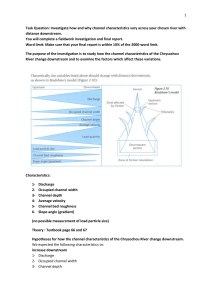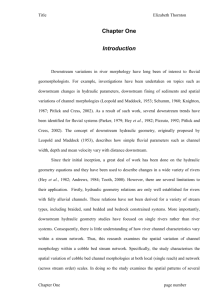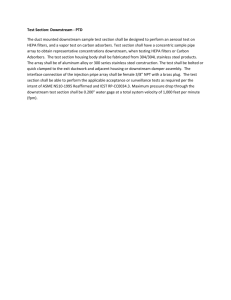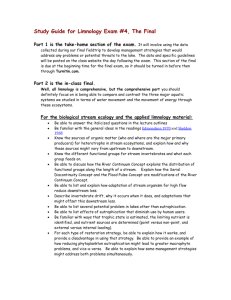Flow Resistance, Channel Gradient, and Hydraulic Geometry
advertisement
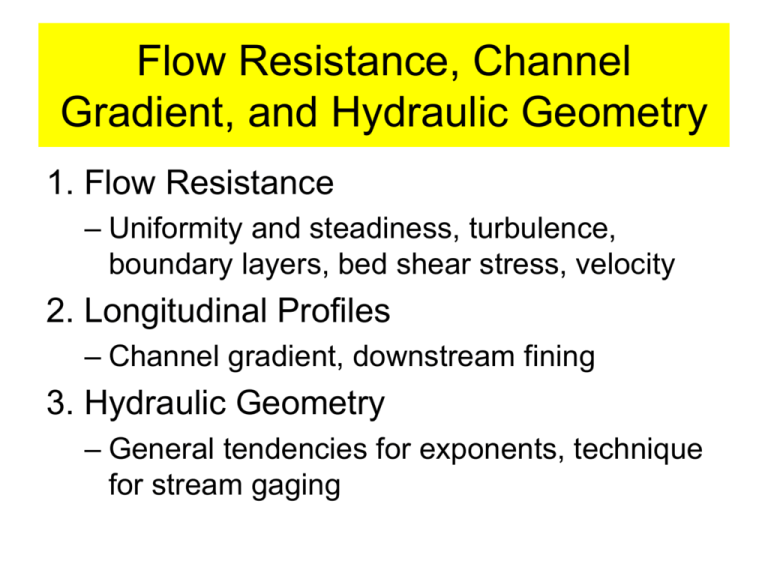
Flow Resistance, Channel Gradient, and Hydraulic Geometry 1. Flow Resistance – Uniformity and steadiness, turbulence, boundary layers, bed shear stress, velocity 2. Longitudinal Profiles – Channel gradient, downstream fining 3. Hydraulic Geometry – General tendencies for exponents, technique for stream gaging Flow Resistance Equations • Chezy (1769) u C RS 23 R S • Manning (1889) u n • Darcy-Weisbach (SI units) R 12 8gRS u f 2 wd d for wide channels w 2d Resistance Coefficients • By assuming a roughness coefficient, u can be determined • Use an input parameters for numerical models (Julien, 2002) Resistance Coefficients as a function of Bed Shear Stress (Bed Configuration) (van Rijn, 1993) 3. Longitudinal Profiles Outline • Controls on channel gradient • Downstream variations in discharge, bed slope, and bed texture (downstream fining) • Downstream fining channel concavity Amazon River Longitudinal Bed Profile Rhine River (Knighton, 1998) River Bollin River Towy Nigel Creek Longitudinal Bed Profile (Knighton, 1998) Controls on Gradient (1) • Mackin (1948) - Concept of a graded stream: Over a period of time, slope is delicately adjusted to provide, with available discharge and channel characteristics, just the velocity required to transport the load supplied • Rubey (1952): for a constant w/d, S Qs, M (size of bed material load), 1/Q Q DsW S k 2 Q d 2 s 13 Controls on Gradient (2) • Leopold and Maddock (1953): S 1/Q S tQ z ; z 0.25 to 0.93 • Lane (1955): Expanded concept of graded stream QS Qs D50 • Hack (1957): S D50, 1/AD D50 S 0.006 AD 0 .6 Longitudinal Variations in Q, S, and Bed Texture, MS River +4° -3° -3° Downstream Fining MS River Allt Dubhaig Downstream Fining D D0e L ; 0.0006 to 0.12 D0 initial grain size, L downstream distance, sorting or abrasion coefficient • Sternberg abrasion equation • Abrasion – mechanical breakdown of particles during transport; rates of DS fining >> rates of abrasion • Weathering – chemical and mechanical due to long periods of exposure; negligible • Hydraulic Sorting – size selective deposition mainly due to a downstream decrease in bed shear stress and turbulence intensity of the river For Mississippi River Data US DS QB (cfs) 260 2,070,000 +4° S 0.035 0.00008 -3° DB (mm) 270 0.16 -3° d = cQf, f ~ 0.3 to 0.4 S = tQz, z ~ -0.65 t = gdS t ds, t (Qf)(Qz) t Qn, where n = -0.25 to -0.35 Assuming t0 ~ tcmax downstream fining d (m) 0.4 13 +1° t (Pa) 124 10 -1° 1D Exner Equation Qs qb h 1 p u s Cb E t x x Change in bed height with time Change in total load with distance • • • • Change in bedload with distance with gain/loss to suspended load as modulated by grain settling velocity Volume transport rates Can be written for sediment mixtures and multiple dimensions Spatial gradients in Qs due to spatial gradients in t Slope adjustment, and downstream fining, can be brought on by aggradation and degradation DS Fining Profile Concavity? • • Modeling suggests the time-scale for sorting processes to produce downstream fining is shorter than the timescale for bed slope adjustment Fluvial systems adjust their bed texture in response to spatial variations in shear stress and sediment supply Measurement of Stream Channel Gradient x Rod Level e1 Rod d1 x1, y1 e2 Water surface Ground surface d2 Water surface slope: x2, y2 (taken positive in the downstream direction) x = x2 x1 y = (e2 d2) (e1 d1) Ground surface slope ≠ water surface slope slope = y/x Hydraulic Geometry • Q is the dominant independent parameter, and that dependent parameters are related to Q via simple power functions w aQ b d cQ f u kQ m Q w d u aQb cQ f kQm b f m 1 ac k 1 • Applied “at-a-station” and “downstream” DS Determining hydraulic geometry (Richards, 1982) f = 0.52 m = 0.30 At-a-station; Sugar Creek, MD b = 0.18 (Leopold, Wolman, and Miller, 1964) Same flow frequency (Morisawa, 1985) Downstream m>f>b and m>b+f b = 0-0.2 f = 0.3-0.5 m = 0.3-0.5 At-a-station (Knighton, 1998) Downstream b > f > m; b~0.5, f~0.4, m~0.1 (Knighton, 1998) Hydraulic Geometry • At-a-station: rectangular channels; increase in discharge is “accommodated” by increasing flow depth and flow velocity • Downstream: increase in discharge is “accommodated” by increasing flow width and depth Hydraulic Geometry as a Tool • Used in stream channel design • Identification of unstable stream corridors and unstable stream systems • Concept of channel equilibrium Additional Considerations • Channel geometry also controlled by – – – – Grain size and bed composition Sediment transport rate (bed mobility and roughness) Bank strength, as assessed by silt-clay content Vegetation—different exponents depending upon presence and type • Curved channels and non-linear trends (compound channels) • Pools & riffles—different exponents Additional Considerations depth velocity width (Richards, 1982) Typical Stream Discharge Determination w0,d0,v0 Tape measure T wn+1,dn+1,vn+1 w1 w2 wn,dn,vn w3 T Q1 Q2 Left Benchmark (looking downstream) d1 Q3 d2 Qn Qn+1 Right Benchmark (looking downstream) d3 v1 Ground surface v2 Current meter Width-v3 and depth-averaged flow discharge: For d<0.75 m, located at 0.4d ; w d For d>0.75 m, average of 0.2d andGeneral 0.8d form: Q vdxdy Discharge determination: Discharge = width depth velocity Q=wdv Q = Q1 + Q2 + Q3 … + Qn+1 For example: d d v v Q1 w1 w0 1 0 1 0 2 2 d d1 v2 v1 Q2 w2 w1 2 2 2 x 0 y 0 n 1 n 1 i 1 i 1 d i d i 1 vi vi 1 2 2 Analytical form: Q Qi wi wi 1 To complete the integration, we will assume w0 0; d 0 00 ; v0 0; wn 1 ww ; d n 1 0; vn 1 0 where n is the number of measurements Implications for Stream Restoration • Roughness coefficients (1) enable determination of velocity and (2) are critical input parameters for numerical models • Exner equation is most commonly used analytic expression to determine bed stability • Hydraulic geometry is (1) the most widely used analytic framework for stream channel design, and (2) used in the identification of unstable stream corridors and unstable stream systems Conclusions • • • • • Flow velocity can be determined by assuming a friction coefficient Downstream variations in channel gradient, bed texture, and bed shear stress despite increases in discharge and total sediment load Hydraulic geometry assumes discharge is the primary independent parameter Hydraulic geometry of river channels shows world-wide tendencies; very powerful “tool” A technique for gaging streams is presented
